
Revenue stamps of Malta were first issued in 1899, when the islands were a British colony. From that year to 1912, all revenue issues were postage stamps overprinted accordingly, that was either done locally or by De La Rue in London. Postage stamps also became valid for fiscal use in 1913, so no new revenues were issued until 1926–30, when a series of key type stamps depicting King George V were issued. These exist unappropriated for use as general-duty revenues, or with additional inscriptions indicating a specific use; Applications, Contracts, Registers or Stocks & Shares. The only other revenues after this series were £1 stamps depicting George VI and Elizabeth II. Postage stamps remained valid for fiscal use until at least the 1980s.

Revenue stamps of the United Kingdom refer to the various revenue or fiscal stamps, whether adhesive, directly embossed or otherwise, which were issued by and used in the Kingdom of England, the Kingdom of Great Britain, the United Kingdom of Great Britain and Ireland and the United Kingdom of Great Britain and Northern Ireland, from the late 17th century to the present day.
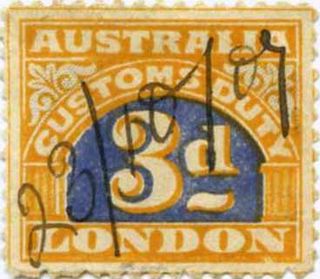
Australia issued revenue stamps from 1907 to 1994. There were various types for different taxes. In addition to Commonwealth issues, the states of New South Wales, Queensland, South Australia, Tasmania, Victoria and Western Australia as well as the territories Australian Capital Territory, North Australia and Northern Territory also had their own stamps.

South Africa issued revenue stamps from 1910 to 2009. Apart from national issues various provinces of the country issued revenues from around 1855 to c. 1970.
The Australian state of Western Australia issued revenue stamps from 1881 to 1973. There were various types for different taxes.

The Australian state of Victoria issued revenue stamps from 1870 to around 2000. There were various types for different taxes.
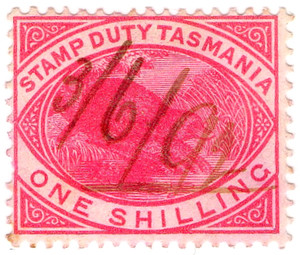
The Australian state of Tasmania issued adhesive revenue stamps from 1863 to 1998, although impressed stamps had appeared briefly in the 1820s. There were general revenue and stamp duty issues, as well as a number of specific issues for various taxes.

The Australian state of South Australia issued revenue stamps from 1894 to 2003. There were various types for different taxes.
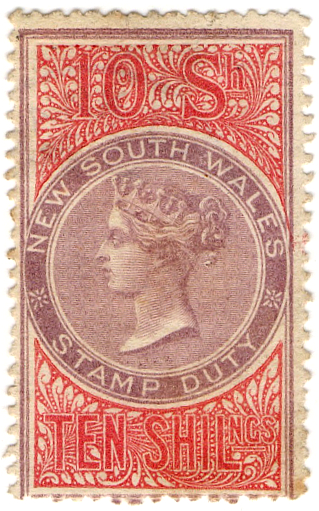
The Australian state of New South Wales issued revenue stamps from 1865 to 1998. There were various types for different taxes.

The Australian territory of Northern Territory, known as North Australia between 1929 and 1935, issued revenue stamps from 1917 to 2006.
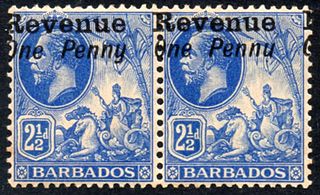
The island of Barbados first issued revenue stamps in 1916. There were various types of fiscal stamps for different taxes.

The South African Republic (ZAR), later known as Transvaal issued revenue stamps from 1875 to around 1950. There were a number of different stamps for several taxes.
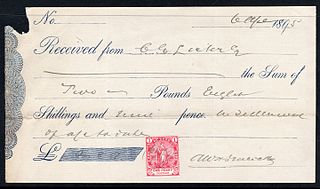
Cape of Good Hope issued revenue stamps from 1864 to 1961. There were a number of different stamps for several taxes.

New Zealand first issued revenue stamps on 1 January 1867 and their general use continued until the early 1950s. The only Revenue Stamp series still in use today is the Game Bird Habitat stamp which is used for payment of the Gun License for the duck shooting season which begins the first weekend of May. There were various types of fiscal stamps for different taxes.
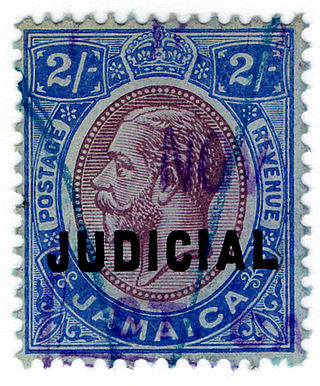
Revenue stamps of Jamaica were first issued in 1855. There were various types of fiscal stamps for different taxes.

Hong Kong issued revenue stamps from 1867 to the 1990s, both when it was a British colony as well as when it was under Japanese occupation.
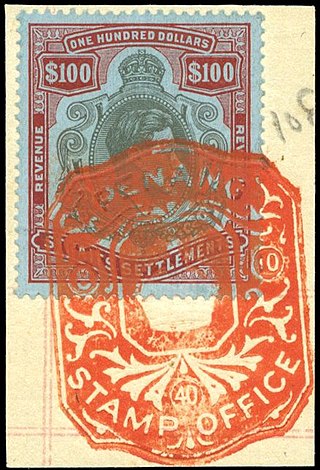
Malaysia first issued revenue stamps as the Straits Settlements in 1863, and continues to do so to this day. Over the years, a number of entities in modern Malaysia have issued revenue stamps.

Uganda issued revenue stamps from around 1896 to the 1990s. There were numerous types of revenue stamps for a variety of taxes and fees.
Revenue stamps of Fiji were first issued in 1871 or 1872, when the Fiji islands were an independent kingdom. The first revenue stamps consisted of postage stamps overprinted with the letter D.

Revenue stamps of Hawaii were first issued in late 1876 by the Kingdom of Hawaii to pay taxes according to the Stamp Duty Act of 1876, although embossed revenue stamps had been introduced decades earlier in around 1845. The stamps issued in 1876–79 were used for over three decades, remaining in use during the Provisional Government, the Republic and after Hawaii became a U.S. Territory. Some changes were made along the years: from rouletted to perforated, and some new values, colours, designs and overprints were added. Some postage stamps were briefly valid for fiscal use in 1886–88 to pay for a tax on opium imports, and a stamp in a new design was issued for customs duties in 1897. A liquor stamp was issued in 1905.

















